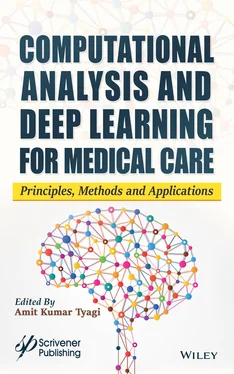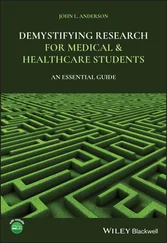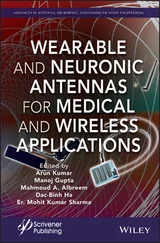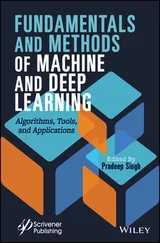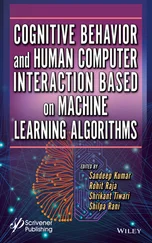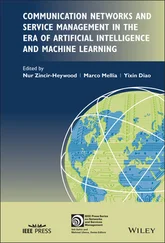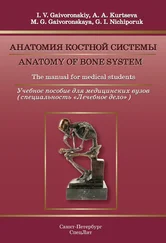7 Chapter 7Figure 7.1 Architecture of the proposed approach.Figure 7.2 Sample Math dataset (including English characters).Figure 7.3 Sample Bangla dataset (including Bangla numeric).Figure 7.4 Sample Devanagari dataset (including Hindi numeric).Figure 7.5 Dataset distribution for English dataset.Figure 7.6 Dataset distribution for Hindi dataset.Figure 7.7 Dataset distribution for Bangla dataset.Figure 7.8 Dataset distribution for Math Symbol dataset.Figure 7.9 Dataset distribution.Figure 7.10 Precision-recall curve on English dataset.Figure 7.11 ROC curve on English dataset.Figure 7.12 Precision-recall curve on Hindi dataset.Figure 7.13 ROC curve on Hindi dataset.Figure 7.14 Precision-recall curve on Bangla dataset.Figure 7.15 ROC curve on Bangla dataset.Figure 7.16 Precision-recall curve on Math Symbol dataset.Figure 7.17 ROC curve on Math symbol dataset.Figure 7.18 Precision-recall curve of the proposed model.Figure 7.19 ROC curve of the proposed model.
8 Chapter 8Figure 8.1 Eye image dissection [34].Figure 8.2 Cataract algorithm [10].Figure 8.3 Pre-processing algorithm [48].Figure 8.4 Pre-processing analysis [39].Figure 8.5 Morphologically opened [39].Figure 8.6 Finding circles [40].Figure 8.7 Iris contour separation [40].Figure 8.8 Image inversion [41].Figure 8.9 Iris detection [41].Figure 8.10 Cataract detection [41].Figure 8.11 Healthy eye vs. retinoblastoma [33].Figure 8.12 Unilateral retinoblastoma [18].Figure 8.13 Bilateral retinoblastoma [19].Figure 8.14 Classification of stages of skin cancer [20].Figure 8.15 Eye cancer detection algorithm.Figure 8.16 Sample test cases.Figure 8.17 Actual working of the eye cancer detection algorithm.Figure 8.18 Melanoma example [27].Figure 8.19 Melanoma detection algorithm.Figure 8.20 Asymmetry analysis.Figure 8.21 Border analysis.Figure 8.22 Color analysis.Figure 8.23 Diameter analysis.Figure 8.24 Completed detailed algorithm.
9 Chapter 9Figure 9.1 Basic overview of a proposed computer-aided system.Figure 9.2 Block diagram of the proposed system for finding out liver fibrosis.Figure 9.3 Block diagram representing different pre-processing stages in liver f...Figure 9.4 Flow chart showing student’s t test.Figure 9.5 Diagram showing SegNet architecture for convolutional encoder and dec...Figure 9.6 Basic block diagram of VGG-16 architecture.Figure 9.7 Flow chart showing SegNet working process for classifying liver fibro...Figure 9.8 Overall process of the CNN of the system.Figure 9.9 The stages in identifying liver fibrosis by using Conventional Neural...Figure 9.10 Multi-layer neural network architecture for a CAD system for diagnos...Figure 9.11 Graphical representation of Support Vector Machine.Figure 9.12 Experimental analysis graph for different classifier in terms of acc...
10 Chapter 10Figure 10.1 Block diagram of machine learning.Figure 10.2 Machine learning algorithm.Figure 10.3 Structure of deep learning.Figure 10.4 Architecture of DNN.Figure 10.5 Architecture of CNN.Figure 10.6 System architecture.Figure 10.7 Image before histogram equalization.Figure 10.8 Image after histogram equalization.Figure 10.9 Edge detection.Figure 10.10 Edge segmented image.Figure 10.11 Total cases.Figure 10.12 Result comparison.
11 Chapter 11Figure 11.1 Breast cancer incidence rates worldwide (source: International Agenc...Figure 11.2 Images from MIAS database showing normal, benign, malignant mammogra...Figure 11.3 Image depicting noise in a mammogram.Figure 11.4 Architecture of CNN.Figure 11.5 A complete representation of all the operation that take place at va...Figure 11.6 An image depicting Pouter, Plesion, and Pbreast in a mammogram.Figure 11.7 The figure depicts two images: (a) mammogram with a malignant mass a...Figure 11.8 A figure depicting the various components of a breast as identified ...Figure 11.9 An illustration of how a mammogram image having tumor is segmented t...Figure 11.10 A schematic representation of classification procedure of CNN.Figure 11.11 A schematic representation of classification procedure of CNN durin...Figure 11.12 Proposed system model.Figure 11.13 Flowchart for MIAS database and unannotated labeled images.Figure 11.14 Image distribution for training model.Figure 11.15 The graph shows the loss for the trained model on train and test da...Figure 11.16 The graph shows the accuracy of the trained model for both test and...Figure 11.17 Depiction of the confusion matrix for the trained CNN model.Figure 11.18 Receiver operating characteristics of the trained model.Figure 11.19 The image shows the summary of the CNN model.Figure 11.20 Performance parameters of the trained model.Figure 11.21 Prediction of one of the image collected from diagnostic center.
12 Chapter 12Figure 12.1 Deep learning [14]. (a) A simple, multilayer deep neural network tha...Figure 12.2 Flowchart of the model [25]. The orange icon indicates the dataset, ...Figure 12.3 Evaluation result [25].Figure 12.4 Deep learning techniques evaluation results [25].Figure 12.5 Deep transfer learning–based screening system [38].Figure 12.6 Classification result.Figure 12.7 Regression result [45].Figure 12.8 AE model of deep learning [47].Figure 12.9 DBN for induction motor fault diagnosis [68].Figure 12.10 CNN model for health monitoring [80].Figure 12.11 RNN model for health monitoring [87].Figure 12.12 Deep learning models usage.
13 Chapter 13Figure 13.1 Intelligent home layout model.Figure 13.2 Deep learning model in predicting behavior analysis.Figure 13.3 Lifestyle-oriented context aware model.Figure 13.4 Components for the identification, simulation, and detection of acti...Figure 13.5 Prediction stages.Figure 13.6 Analytics of event.Figure 13.7 Prediction of activity duration.
14 Chapter 14Figure 14.1 Comparison of normal and Alzheimer brain.Figure 14.2 Proposed AD prediction system.Figure 14.3 KNN classification.Figure 14.4 SVM classification.Figure 14.5 Load data in 3D slicer.Figure 14.6 3D slicer visualization.Figure 14.7 Normal patient MRI.Figure 14.8 Alzheimer patient MRI.Figure 14.9 Comparison of hippocampus region.Figure 14.10 Accuracy of algorithms with baseline records.Figure 14.11 Accuracy of algorithms with current records.Figure 14.12 Comparison of without and with dice coefficient.
15 Chapter 15Figure 15.1 U-Net architecture [19].Figure 15.2 Architecture of the 3D-DCSRN model [29].Figure 15.3 SMILES code for Cyclohexane and Acetaminophen [32].Figure 15.4 Medical chatbot architecture [36].
16 Chapter 16Figure 16.1 A classical perceptron.Figure 16.2 Forward and backward paths on an ANN architecture.Figure 16.3 A DNN architecture.Figure 16.4 A DNN architecture for digit classification.Figure 16.5 Underfit and overfit.Figure 16.6 Functional mapping.Figure 16.7 A generalized Tikhonov functional.Figure 16.8 (a) With hidden layers (b) Dropping h2 and h5.Figure 16.9 Image cropping as one of the features of data augmentation.Figure 16.10 Early stopping criteria based on errors.Figure 16.11 (a) Convex, (b) Non-convex.Figure 16.12 (a) Affine (b) Convex function.Figure 16.13 Workflow and an optimizer.Figure 16.14 (a) Error (cost) function (b) Elliptical: Horizontal cross section.Figure 16.15 Contour plot for a quadratic cost function with elliptical contours...Figure 16.16 Gradients when steps are varying.Figure 16.17 Local minima. (When the gradient ∇ of the partial derivatives is po...Figure 16.18 Contour plot showing basins of attraction.Figure 16.19 (a) Saddle point S. (b) Saddle point over a two-dimensional error s...Figure 16.20 Local information encoded by the gradient usually does not support ...Figure 16.21 Direction of gradient change.Figure 16.22 Rolling ball and its trajectory.
17 Chapter 17Figure 17.1 Artificial Neural Networks vs. Architecture of Deep Learning Model [...Figure 17.2 Machine learning and deep learning techniques [4, 5].Figure 17.3 Model of reinforcement learning (https://www.kdnuggets.com).Figure 17.4 Data analytical model [5].Figure 17.5 Support Vector Machine—classification approach [1].Figure 17.6 Expected output of K-means clustering [1].Figure 17.7 Output of mean shift clustering [2].Figure 17.8 Genetic Signature–based Hierarchical Random Forest Cluster (G-HR Clu...Figure 17.9 Artificial Neural Networks vs. Deep Learning Neural Networks.Figure 17.10 Architecture of Convolution Neural Network.Figure 17.11 Architecture of the Human Diseases Pattern Prediction Technique (EC...Figure 17.12 Comparative analysis: processing time vs. classifiers.Figure 17.13 Comparative analysis: memory usage vs. classifiers.Figure 17.14 Comparative analysis: classification accuracy vs. classifiers.Figure 17.15 Comparative analysis: sensitivity vs. classifiers.Figure 17.16 Comparative analysis: specificity vs. classifiers.Figure 17.17 Comparative analysis: FScore vs. classifiers.
Читать дальше
